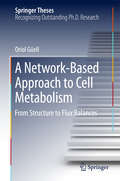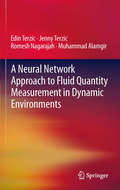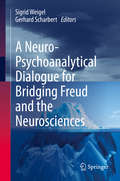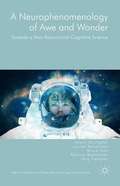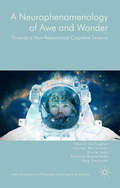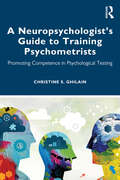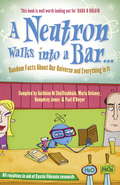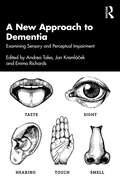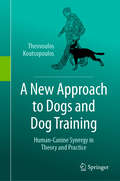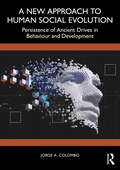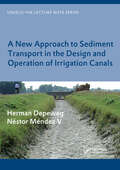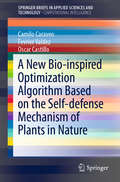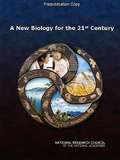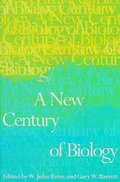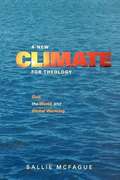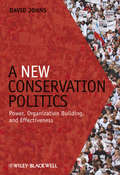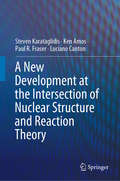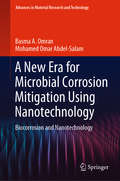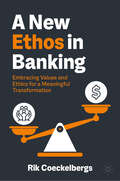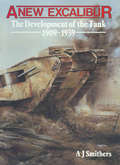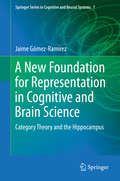- Table View
- List View
A Nest on My Porch
by Buffy Silverman Paige Billin-FryeWhen two robins build a nest and start to raise a family on the porch, a young buy uses his nature notebook to record his observations. He gets to watch as the eggs hatch into nestlings, and the nestlings grow into fledglings! Do you have robins where you live?
A Network-Based Approach to Cell Metabolism
by Oriol GüellThis thesis uses a systems-level approach to study the cellular metabolism, unveiling new mechanisms and responses that were impossible to reach with traditional reductionists procedures. The results reported here have a potential application in areas like metabolic engineering and disease treatment. They could also be used in determining the accuracy of the gene essentiality of new genome-scale reconstructions.Different methods and techniques, within the contexts of Systems Biology and the field known as Complex Networks Analysis have been applied in this work to show different features of the robustness of metabolic networks. The specific issues addressed here range from pure topological aspects of the networks themselves to the balance of biochemical fluxes.
A Neural Network Approach to Fluid Quantity Measurement in Dynamic Environments
by Edin Terzic Romesh Nagarajah Muhammad Alamgir Jenny TerzicSloshing causes liquid to fluctuate, making accurate level readings difficult to obtain in dynamic environments. The measurement system described uses a single-tube capacitive sensor to obtain an instantaneous level reading of the fluid surface, thereby accurately determining the fluid quantity in the presence of slosh. A neural network based classification technique has been applied to predict the actual quantity of the fluid contained in a tank under sloshing conditions. In A neural network approach to fluid quantity measurement in dynamic environments, effects of temperature variations and contamination on the capacitive sensor are discussed, and the authors propose that these effects can also be eliminated with the proposed neural network based classification system. To examine the performance of the classification system, many field trials were carried out on a running vehicle at various tank volume levels that range from 5 L to 50 L. The effectiveness of signal enhancement on the neural network based signal classification system is also investigated. Results obtained from the investigation are compared with traditionally used statistical averaging methods, and proves that the neural network based measurement system can produce highly accurate fluid quantity measurements in a dynamic environment. Although in this case a capacitive sensor was used to demonstrate measurement system this methodology is valid for all types of electronic sensors. The approach demonstrated in A neural network approach to fluid quantity measurement in dynamic environments can be applied to a wide range of fluid quantity measurement applications in the automotive, naval and aviation industries to produce accurate fluid level readings. Students, lecturers, and experts will find the description of current research about accurate fluid level measurement in dynamic environments using neural network approach useful.
A Neuro-Psychoanalytical Dialogue for Bridging Freud and the Neurosciences
by Sigrid Weigel Gerhard ScharbertThe book presents an overview of the term neuropsychoanalysis and traces its historical and scientific foundations as well as its cultural implications. It also turns its attention to some blind spots, open questions, and to what the future may hold. It examines the cooperative and conflicted relationship between psychoanalysis and neuroscience. Articles from different fields investigate the neurological basis of psychoanalysis as well as the psychological terms of neurology. They also discuss what psychoanalysis has to offer neuroscience. In addition, the emerging neuro-psychoanalytical dialogue is enriched here by the voice of a culturally informed history of science. The book brings leading authorities on these topics into conversation with each other, creating an unprecedented opportunity to better understand the 'language' of the psyche. Specific concerns include the discussion of corporeality, how the body figures into psychoanalysis, the meaning of the unconscious in connection with dreams, unconscious fantasies, and the field of epigenetics. Following a historical perspective the book provides a re-reading of Freud's drive theory, exploring his concept of 'life' at the threshold of science and culture as well as the relationship between various representations, somatic states and the origin of drive. Overall, the book argues that if the different methodological approaches of psychoanalysis and neuroscience are acknowledged not only for their individual uniqueness but also as a dialectic, then the resulting epistemological and methodological dialogue might open up a fascinating body of neuropsychoanalytical knowledge.
A Neurophenomenology of Awe and Wonder: Towards a Non-Reductionist Cognitive Science (New Directions In Philosophy And Cognitive Science)
by Shaun Gallagher Lauren Reinerman-Jones Bruce Janz Patricia Bockelman Jörg TremplerA Neurophenomenology of Awe and Wonder
A Neurophenomenology of Awe and Wonder: Towards a Non-Reductionist Cognitive Science (New Directions in Philosophy and Cognitive Science)
by Shaun Gallagher Bruce Janz Patricia Bockelman Jörg Trempler Lauren ReinermanThis book presents a study of the various feelings of awe and wonder experienced by astronauts during space flight. It summarizes the results of two experimental, interdisciplinary studies that employ methods from neuroscience, psychology, phenomenology and simulation technology, and it argues for a non-reductionist approach to cognitive science.
A Neuropsychologist’s Guide to Training Psychometrists: Promoting Competence in Psychological Testing
by Christine S. GhilainA Neuropsychologist's Guide to Training Psychometrists: Promoting Competence in Psychological Testing provides a framework for busy neuropsychologists faced with training their newly-hired psychometrist. It supplies concrete guidelines and provides a roadmap for training that can be customized to any practice, department, or clinic setting. In this essential resource, Dr. Christine S. Ghilain discusses the role of the psychometrist in various neuropsychological practice settings and provides suggested minimum standards of competence across training domains. She dives deeply into the core components of assessment—from optimizing testing conditions, to standardized test administration, to keen observations of behavior—and includes coverage of topics such as testing with unique populations, behavioral management strategies for challenging situations, as well as promoting ongoing competence over time. A compilation of several sources of data, the book includes excerpts from Dr. Ghilain’s practice-specific psychometry training manual along with advice and illustrative examples from many neuropsychologists and psychometrists who shared their experiences. This book is an indispensable guide for neuropsychologists looking to instill high standards of competence in their hired professionals and for those involved in training graduate students who are just learning to administer cognitive tests. It is also of interest to other assessment-focused professionals looking to enhance their skills and refine their psychological testing knowledge.
A Neutron Walks Into a Bar... Random Facts about Our Universe and Everything in It: Random Facts About Our Universe And Everything In It
by Science140Fun, quirky and informative, A Neutron Walks Into A Bar... is a collection of facts, definitions, explanations, biographies and jokes guaranteed to quench a thirst for knowledge, discovery and humour that's out of the ordinary.Did you know that water is the only thing found naturally on earth in each of the 3 states of matter?This book began its life as Science140, an exciting social media project co-ordinated by four Irish science communicators and enthusiasts including Aoibhinn Ní Shúilleabháin presenter of RTE's The Science Squad, Maria Delaney, Humphrey Jones and Paul O'Dwyer. Since its launch on Twitter in the spring of 2012, thousands of tweets have been collected, each explaining a scientific principle, fact, joke or biography in 140 characters or less. The tweets collected are on a range of topics from astronomy to zoology, and have been compiled by science enthusiasts, educators, members of the public and celebrities from all over the world.Did you know that the Mississippi alligator can stay underwater for 6 hours?Neither a textbook nor a definitive guide to science, A Neutron Walks Into a Bar... is a fun way to learn new, interesting and unusual things about the world we live in!All royalties in aid of Cystic Fibrosis research.
A New Approach to Dementia: Examining Sensory and Perceptual Impairment
by Emma Richards Andrea Tales Jan KremláčekA New Approach to Dementia: Examining Sensory and Perceptual Impairment is a groundbreaking work which highlights the non-memory impairments of the dementias to improve both early recognition of dementia and clinical diagnosis, as well as interventions and care. It focuses clinical attention on the significant evidence supporting the existence of many types of sensory and perception-related changes/abnormalities sometimes at the early stages of the disease and throughout its progression.Providing a holistic overview of the field, the book includes self-reports of people with dementia and caregivers, alongside an in-depth discussion of the application of the findings about non-memory impairments to clinical care and management. It leads a movement to address the over-focus on memory function in dementia and ageing, arguing for the need to test sensory and perceptual abnormalities to improve clinical practice and research into, and the care and support of, people living with dementia and associated disorders.With its mix of scientific, and clinical and real-life relevance, this book is essential for clinicians and researchers specialising in ageing and dementia as well as carers working with people living with dementia and students of neuropsychology/neurocognition, medicine and health and social care.
A New Approach to Dogs and Dog Training: Human-Canine Synergy in Theory and Practice
by Theovoulos KoutsopoulosThis book presents a new and innovative concept in dealing with dogs: the human-canine synergy (HCS), characterized by a holistic nature and its differentiation from unidimensional terms expressing the affiliation of humans and dogs (Relationship, Interaction, Bonding). Related to the use and training by humans, it applies three main categories of dogs: a) the empathy/therapeutic individuals, which are dogs helping persons with empathy- or therapeutic needs; b) assisting/working dogs carrying out specific actions to aid or assist humans perform specific tasks; and c) the facilitating/inspiring dogs, which enable or improve various human activities, including classroom dogs for teaching and learning purposes in almost all educational subjects.Organized in three parts, chapters address the following needs:• The first section illuminates the concept of HCS as well as basic principles determining this synergy and consequently the process of training dogs (owners and professional trainers). Readers will understand the role of a dog's personality, behavior and especially temperament in its successful training.• In a scientifically documented way, the second part guides those who wish to engage in dog training (amateur or professional). It describes basic training forms within the HCS framework (obedience, protection, detection and classroom dog) and necessary steps for proper completion.• The third book part describes the business of dog training with multi-dimensional approach by emphasizing a good understanding and knowledge of interactions and the environment in which trainer, owner and dog typically operate.Overall, this work is a valuable read for anyone who deals with our four-legged companions for business or pleasure.
A New Approach to Human Social Evolution: Persistence of Ancient Drives in Behaviour and Development
by Jorge A. ColomboThis book provides an important examination into the role of evolution of human traits of dominance as central to understanding social and political events, proposing a new view on human social evolution. It also examines basic biological universal needs and behavioural profiles of non- human living beings, from which humans share essential survival components. It invites readers to think critically about the psychological evolution of the human brain. Using comparative psychology, it argues that the core of human behaviour lies in the ancient, animal, universal set of survival resources hidden under various socialization profiles. However, it generally fails to replace drives of dominance and aggression for physical and social survival. Genuine replacement of those primal behavioural drives would require fundamental neuro- socio- behavioural changes. This book supports the thesis that without education and the promotion of universal values involving environmental protection and individual opportunities to evolve, there will be negative consequences for individuals and communities. This book represents a critical tool for students of behavioural sciences, anthropology, politics, and evolutionary neurosciences, and will also greatly benefit other readers, such as teachers and professional researchers.
A New Approach to Sediment Transport in the Design and Operation of Irrigation Canals: UNESCO-IHE Lecture Note Series (Ihe Delft Lecture Note Ser.)
by Herman Depeweg Néstor Méndez VThe transport of sediment greatly influences the sustainability of an irrigation system. Erosion and deposition not only increase maintenance costs, but may result in an inequitable and inadequate distribution of irrigation water. Understanding the behaviour and transport of sediment allows efficient planning and reliable water delivery schedules,
A New Bio-inspired Optimization Algorithm Based on the Self-defense Mechanism of Plants in Nature (SpringerBriefs in Applied Sciences and Technology)
by Oscar Castillo Fevrier Valdez Camilo CaraveoThis book presents a new meta-heuristic algorithm, inspired by the self-defense mechanisms of plants in nature. Numerous published works have demonstrated the various self-defense mechanisms (survival strategies) plants use to protect themselves against predatory organisms, such as herbivorous insects. The proposed algorithm is based on the predator–prey mathematical model originally proposed by Lotka and Volterra, consisting of two nonlinear first-order differential equations, which allow the growth of two interacting populations (prey and predator) to be modeled. The proposed meta-heuristic is able to produce excellent results in several sets of benchmark optimization problems. Further, fuzzy logic is used for dynamic parameter adaptation in the algorithm.
A New Biology for the 21st Century
by National Research Council of the National AcademiesNow more than ever, biology has the potential to contribute practical solutions to many of the major challenges confronting the United States and the world. A New Biology for the 21st Century recommends that a "New Biology" approach--one that depends on greater integration within biology, and closer collaboration with physical, computational, and earth scientists, mathematicians and engineers--be used to find solutions to four key societal needs: sustainable food production, ecosystem restoration, optimized biofuel production, and improvement in human health. The approach calls for a coordinated effort to leverage resources across the federal, private, and academic sectors to help meet challenges and improve the return on life science research in general.
A New Century of Biology
by John W. Kress Gary W. BarrettIn the twentieth century, scientists in the relatively new field of biology played an important role in exposing the threats of environmental degradation, loss of species diversity, habitat fragmentation, scarce energy resources, and human population growth. In the essays found in A New Century of Biology, some of the world's most notable biologists consider how their discipline must evolve to address these problems in the twenty-first century. The next one hundred years, the contributors argue, will likely be dominated by breakthroughs in evolutionary biology and systems ecology; by an increased need for scientists to integrate research, teaching, and service missions; and by problem-solving ventures on greater spatial and temporal scales. Because human activity and increased population will continue to have a profound impact on the environment, biologists must define an effective strategy for integrating the biological sciences with global economics and human social structure.The eleven contributors are leaders in the fields of ecology, and evolution, morphology, and development, behavior, microbiology, ecosystem energetics and biogeochemistry, biodiversity and conservation biology, and human sciences. While acknowledging the real problems their discipline must address, they offer an optimistic agenda for the future.
A New Climate For Theology: God, The World, And Global Warming
by Sallie McFagueClimate change promises monumental changes to human and other planetary life in the next generations. Yet government, business, and individuals have been largely in denial of the possibility that global warming may put our species on the road to extinction. Further, says Sallie McFague, we have failed to see the real root of our behavioral troubles in an economic model that actually reflects distorted religious views of the person. At its heart, she maintains, global warming occurs because we lack an appropriate understanding of ourselves as inextricably bound to the planet and its systems. A New Climate for Theology not only traces the distorted notion of unlimited desire that fuels our market system; it also paints an alternative idea of what being human means and what a just and sustainable economy might mean. Convincing, specific, and wise, McFague argues for an alternative economic order and for our relational identity as part of an unfolding universe that expresses divine love and human freedom. It is a view that can inspire real change, an altered lifestyle, and a form of Christian discipleship and desire appropriate to who we really are. Table of Contents Preface Part One: The Science and its Significance for Theology Chapter 1: Climate Change: The Evidence and Consequences Chapter 2: Global Warming: A Theological Problem Part Two: Exploring God and the World within Climate Change Chapter 3: Who Are We? Ecological Anthropology Chapter 4: Who Is God? Creation and Providence Chapter 5: How Shall We Live? Christianity and Planetary Economics Part Three: Serving God and City Living within Climate Change Chapter 6: Why We Worship: Praise and Compassion as Intimations of Transcendence Chapter 7: Where We Live: Urban Ecotheology Part Four: Despair and Hope within Climate Change Chapter 8: Is a Different World Possible? Human Dignity and the Integrity of Creation in a Time of Global Warming Chapter 9: ?The Dearest Freshness Deep Down Things: The Holy Spirit and Climate Change Notes
A New Conservation Politics: Power, Organization Building and Effectiveness
by David JohnsDespite many successes in the field of conservation, species extinction rates continue to climb and wild areas and habitats continue to be lost. Many look to more (or better) biology and ecology to solve the problem but the obstacles are not just scientific but political. To stop the 6th great extinction the conservation movement must become much stronger, more tenacious, and more effective. By learning from its own history and especially from the movements that abolished slavery, brought down apartheid, changed gender relations, and expanded democratic rights, conservationists can become more successful. This book brings together in one place and in a highly usable format the lessons of those movements culled from practitioners and academic analysts. "Protecting Earth's rich web of life, and our only known living companions in the universe, depends upon people caring enough to act. This book shows conservationists how to evoke the caring and action necessary to change policy and ultimately society." Paul R Ehrlich, Bing Professor of Population Studies, Stanford University and author of The Dominant Animal: Human Evolution and the Environment “This timely book by David Johns explains why facts alone don’t motivate and mobilize people to care for the natural world. Even better, Johns spells out what will work, based on a frank and informed assessment of human nature applied to social and political movements. If you would rather see change than be right, this readable and authoritative guide should be your bible.” Michael Soulé, Professor Emeritus, Environmental Studies, University of California, Santa Cruz “For me, this is a truly fascinating book. I spend much of my time writing--trying to write the stories we need to tell--and the rest of it helping run national and global mobilizations on climate change (Step It Up and now 350.org). I think David Johns has done a tremendous job of linking together insights about useful rhetoric and very practical notions about organizing. If you're trying to save a river, a forest, or a planet you need to read this book.” Bill McKibben, Scholar-in-Residence, Middlebury College
A New Development at the Intersection of Nuclear Structure and Reaction Theory
by Steven Karataglidis Ken Amos Paul R. Fraser Luciano CantonThis book highlights a major advance in low-energy scattering theory: the Multi-Channel Algebraic Scattering (MCAS) theory, which represents an attempt to unify structure and reaction theory. It solves the Lippmann–Schwinger equations for low-energy nucleon-nucleus and alpha-nucleus scattering in momentum space, allowing both the bound and scattering states in the compound nucleus formed to be described. Results of various cases are presented and discussed.
A New Era for Microbial Corrosion Mitigation Using Nanotechnology: Biocorrosion and Nanotechnology (Advances in Material Research and Technology)
by Basma A. Omran Mohamed Omar Abdel-SalamThis book focuses on corrosion and microbial corrosion, providing solutions for these problems based on nanotechnology and nanobiotechnology. It introduces the causes, consequences, cost and control of corrosion processes. It gives a particular emphasis on microbial corrosion of steel and other metals in oil, gas and shipping industries. The book presents the materials vulnerable to such kind of corrosion, and the use of nanomaterials to control it.
A New Ethos in Banking: Embracing Values and Ethics for a Meaningful Transformation
by Rik CoeckelbergsThe financial services industry has one constant lately - change. What are the lessons of the past 25 years, and what can be done better in the future, especially when it comes to digital transformation and sustainability? This book investigates how change is impacting banking and the industry’s reputation, exploring what a new ethos in banking should look like, and, more importantly, the needed contributions from the industry to the road ahead. Based on interviews with industry leaders and the author's own personal experience, this book guides decision-makers in a new direction, a positive alternative to the status quo. The book is an urgent call to action, with practical and relevant insights to improve a bank’s societal footprint beyond the required compliance and regulatory efforts into sustainability, transparency, and ethics in banking. It will inspire those that look for successful stakeholder models without ignoring shareholder interests, putting people and society first, and understanding this can only work with a healthy financial model.
A New Excalibur: The Development of the Tank 1909–1939
by A. J. SmithersThe story of the inventors, engineers, soldiers, and politicians behind the emergence of the armored fighting vehicle. The birth and infancy of the tank had an enormous number of technical problems to be solved—but the issues with its construction paled in comparison to the endless squabbles among the people involved. This fascinating study of the vehicle which was born out of the stalemate of the Western Front in the First World War looks at all the obstacles that had to be overcome. As is inevitable in almost any work of history set in the first half of the century, the figure of Winston Churchill looms large—but the role that he played in this instance is remarkable even by his standard, when it is remembered that at the crucial time he was First Lord of the Admiralty and theoretically had nothing to do with warfare on land. Foremost among the leading actors in the drama are Sir Eustace Tennyson-d&’Eyncourt, Sir Ernest Swinton, Bertie Stern, Sir William Tritton, and Walter Gordon Wilson. This is the first exhaustive study of the men behind the earliest tanks. The story of their furious quarrels and the machines they produced combine to make a remarkable and compelling study.
A New Foundation for Representation in Cognitive and Brain Science: Category Theory and the Hippocampus (Springer Series in Cognitive and Neural Systems #7)
by Jaime Gómez-RamirezThe purpose of the book is to advance in the understanding of brain function by defining a general framework for representation based on category theory. The idea is to bring this mathematical formalism into the domain of neural representation of physical spaces, setting the basis for a theory of mental representation, able to relate empirical findings, uniting them into a sound theoretical corpus. The innovative approach presented in the book provides a horizon of interdisciplinary collaboration that aims to set up a common agenda that synthesizes mathematical formalization and empirical procedures in a systemic way. Category theory has been successfully applied to qualitative analysis, mainly in theoretical computer science to deal with programming language semantics. Nevertheless, the potential of category theoretic tools for quantitative analysis of networks has not been tackled so far. Statistical methods to investigate graph structure typically rely on network parameters. Category theory can be seen as an abstraction of graph theory. Thus, new categorical properties can be added into network analysis and graph theoretic constructs can be accordingly extended in more fundamental basis. By generalizing networks using category theory we can address questions and elaborate answers in a more fundamental way without waiving graph theoretic tools. The vital issue is to establish a new framework for quantitative analysis of networks using the theory of categories, in which computational neuroscientists and network theorists may tackle in more efficient ways the dynamics of brain cognitive networks. The intended audience of the book is researchers who wish to explore the validity of mathematical principles in the understanding of cognitive systems. All the actors in cognitive science: philosophers, engineers, neurobiologists, cognitive psychologists, computer scientists etc. are akin to discover along its pages new unforeseen connections through the development of concepts and formal theories described in the book. Practitioners of both pure and applied mathematics e. g. , network theorists, will be delighted with the mapping of abstract mathematical concepts in the terra incognita of cognition.
A New Generation of Cosmic Superstring Simulations (Springer Theses)
by José Ricardo CorreiraTopological defects are an expected consequence of phase transitions in the early Universe. As such these objects, if detected, provide unequivocal evidence of physics beyond the Standard Model. This means they are prime targets for new observational facilities. However, our understanding of defects is heavily bottlenecked by computational limitations. In this book, the author explores the use of accelerator hardware to alleviate this problem, presenting the world’s first (multiple-)GPU defect simulations. Such simulations can evolve a network of line-like cosmic strings at an unprecedented resolution. Then these are used to obtain the most accurate to date calibrations of semi-analytical modelling and to show the impact of accuracy on observational consequences of strings. Lastly, a modified version of this application is used to study interconnected networks of strings in greater detail than ever before. This book benefits any student or researcher who wishes to learn about field theory simulations in the early Universe and about supercomputing with multiple accelerators.
A New Generation of High-Power, Waveform Controlled, Few-Cycle Light Sources (Springer Theses)
by Marcus SeidelThis thesis presents first successful experiments to carrier-envelope-phase stabilize a high-power mode-locked thin-disk oscillator and to compress the pulses emitted from this laser to durations of only a few-optical cycles. Moreover, the monograph introduces several methods to achieve power-scalability of compression and stabilization techniques. All experimental approaches are compared in detail and may serve as a guideline for developing high-power waveform controlled, few-cycle light sources which offer tremendous potential to exploit extreme nonlinear optical effects at unprecedentedly high repetition rates and to establish table-top infrared light sources with a unique combination of brilliance and bandwidth. As an example, the realization of a multi-Watt, multi-octave spanning, mid-infrared femtosecond source is described. The thesis starts with a basic introduction to the field of ultrafast laser oscillators. It subsequently presents additional details of previously published research results and establishes a connection between them. It therefore addresses both newcomers to, and experts in the field of high-power ultrafast laser development.
A New Generation of Ultrafast Oscillators for Mid-Infrared Applications (Springer Theses)
by Nathalie NaglThis thesis presents the first successful realization of a compact, low-noise, and few-cycle light source in the mid-infrared wavelength region. By developing the technology of pumping femtosecond chromium-doped II-VI laser oscillators directly with the emission of broad-stripe single-emitter laser diodes, coherent light was generated with exceptionally low amplitude noise — crucial for numerous applications including spectroscopy at high sensitivities. Other key parameters of the oscillator's output, such as pulse duration and output power, matched and even surpassed previous state-of-the-art systems. As a demonstration of its unique capabilities, the oscillator's powerful output was used to drive — without further amplification — the nonlinear generation of coherent mid-infrared light spanning multiple octaves. The resulting table-top system uniquely combines high brilliance and ultrabroad spectral bandwidth in the important mid-infrared spectral range. The rapid development of this technology is comprehensively and lucidly documented in this PhD thesis. Together with a thorough review of literature and applications, and an extensive analysis of the theoretical foundations behind ultrafast laser oscillators, the thesis will serve as a valuable reference for the construction of a new generation of mid-infrared light sources.

